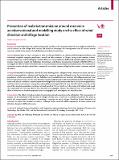| dc.contributor.author | Endo, Noriko | |
| dc.contributor.author | Eltahir, Elfatih A. B. | |
| dc.date.accessioned | 2020-06-23T18:17:59Z | |
| dc.date.available | 2020-06-23T18:17:59Z | |
| dc.date.issued | 2018-09 | |
| dc.identifier.issn | 2542-5196 | |
| dc.identifier.uri | https://hdl.handle.net/1721.1/125944 | |
| dc.description.abstract | Published by Elsevier Ltd. This is an Open Access article under the CC BY NC-ND 4.0 license Background: Many large dams are constructed annually in Africa, with associated reservoirs that might exacerbate the risk of malaria in new villages built nearby. We aimed to investigate the heterogeneous risk of malaria around reservoirs related to the impact of wind direction on malaria transmission. Methods: Between June 15, 2012, and April 22, 2015, we obtained field data on climate and hydrological conditions, and monitored Anopheles mosquito populations around the Koka reservoir in Ethiopia using in-situ weather stations, mosquito light traps, and larval dipping. The field data were used to calibrate a field-tested, spatially explicit mechanistic malaria transmission model, the Hydrology, Entomology, and Malaria Transmission Simulator (HYDREMATS), to investigate the effect of relative wind direction on malaria transmission and associated mechanisms. We combined our simulation results and observational data to assess the association between village location around a reservoir and risk of malaria. Findings: HYDREMATS simulations showed that wind blowing from a village towards a reservoir increases the size of malaria vector populations, whereas wind blowing from a reservoir towards a village decreases the size of malaria vector populations, which was consistent with our field data. Larval mortality is low in locations with village-to-reservoir wind due to weak surface waves, and this wind direction creates conditions that enable mosquitoes to identify village locations more easily than in conditions caused by reservoir-to-village wind, which increases the size of malaria vector populations, and thus malaria transmission. Among the wind conditions investigated (0·5–5 m/s), the effect of CO2attraction on the size of the Anopheles population was largest at wind speeds of 0·5 m/s and 1 m/s, decreasing with higher wind speed. At a wind speed of 5 m/s, the effect of CO2attraction was negligible, whereas the effect of waves was strongest. The effect of advection on Anopheles population size was negligible at all wind speeds and wind directions. Interpretation: The effect of wind on malaria transmission around reservoirs can be substantial. The transmission of malaria can be minimised if the location of villages situated near a reservoir is carefully considered. For areas in which the environmental conditions surrounding a resevoir are equal, villages should be located downwind of reservoirs to reduce the incidence of malaria, although further research will be required in locations where wind direction changes in different seasons. Funding: US National Science Foundation, and Cooperative Agreement between the Masdar Institute of Science and Technology, Abu Dhabi, UAE, and the Massachusetts Institute of Technology, Cambridge, MA, USA. | en_US |
| dc.publisher | Elsevier BV | en_US |
| dc.relation.isversionof | http://dx.doi.org/10.1016/s2542-5196(18)30175-x | en_US |
| dc.rights | Creative Commons Attribution-NonCommercial-NoDerivs License | en_US |
| dc.rights.uri | http://creativecommons.org/licenses/by-nc-nd/4.0/ | en_US |
| dc.source | Elsevier | en_US |
| dc.title | Prevention of malaria transmission around reservoirs: an observational and modelling study on the effect of wind direction and village location | en_US |
| dc.type | Article | en_US |
| dc.identifier.citation | Endo, Noriko and Elfatih A B Eltahir. “Prevention of Malaria Transmission Around Reservoirs: An Observational and Modelling Study on the Effect of Wind Direction and Village Location.” The Lancet Planetary Health 2, 9 (September 2018): e406–e413 © 2018 The Author(s) | en_US |
| dc.contributor.department | Massachusetts Institute of Technology. Department of Civil and Environmental Engineering | |
| dc.contributor.department | Parsons Laboratory for Environmental Science and Engineering (Massachusetts Institute of Technology) | |
| dc.relation.journal | The Lancet Planetary Health | en_US |
| dc.eprint.version | Final published version | en_US |
| dc.type.uri | http://purl.org/eprint/type/JournalArticle | en_US |
| eprint.status | http://purl.org/eprint/status/PeerReviewed | en_US |
| dc.date.updated | 2019-02-15T15:16:28Z | |
| dspace.embargo.terms | N | en_US |
| dspace.date.submission | 2019-04-04T15:24:14Z | |
| mit.journal.volume | 2 | en_US |
| mit.journal.issue | 9 | en_US |
| mit.license | PUBLISHER_CC | en_US |
| mit.metadata.status | Complete | |
